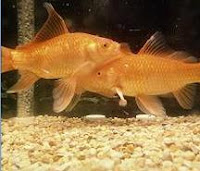.
 African Lungfish
African LungfishThe African lungfish is one of three species of lungfish. This lungfish is equipped with both a lung and rudimentary gills. During the dry season, the African lungfish is able to survive by curling itself into a tight ball with its tail covering the eyes. Mud adheres to the body mucous, forming an impervious casing. The lungfish then becomes dormant, or estivates, until the rainy season again fills the pool, softens the mud casing, and releases the fish.
 Betta
BettaThe betta, or Siamese fighting fish, is native to Southeast Asia. It has been extensively cultured for the aquarium trade. Cultured bettas have long, flowing fins and brilliant colors. They must periodically swim to the surface to capture air in a specialized structure called a labyrinth organ. By breathing atmospheric oxygen, bettas are able to inhabit oxygen-poor waters where few other fish can survive.
 Bicolor Parrot Fish
Bicolor Parrot FishParrot fish have the unusual ability to change gender. This female bicolor parrot fish may have been a male in the past, or may transform into a male soon. Parrot fish use their strong jaws to break off small pieces of coral and graze on algae growing among the coral.
 Brown Bullhead
Brown BullheadValued for food and sport, the brown bullhead, a North American species of catfish, lives in many freshwater streams in the eastern United States. Usually measuring less than 46 cm (18 in) long, the brown bullhead exhibits the typical whiskerlike feelers that give the catfish its name. The brown bullhead is considered the most commercially important of all catfish.
 Butterfly Fish
Butterfly FishThe butterfly fish is a member of the order Perciformes, the largest order of bony fishes. Hundreds of species of butterfly fish are found on coral reefs around the world. Fast and flexible, they can dart quickly into coral crevices to avoid predators and chase after food items. Most species of butterfly fish are brightly colored and patterned, with one or more false eyespots on the fins. This type of coloration serves to disrupt the outline of the body against the background of the coral reef, making it difficult for predators to detect them.
 Chain Moray
Chain MorayThe chain moray, a coral reef dweller, is a member of the eel family, fish that occasionally lack fins and whose gill openings are reduced to small circular openings. Secretive by nature, the chain morays usually inhabit a coral cave or crevice and wait for unsuspecting fish and invertebrates, which they capture with their sharp teeth and powerful jaws.
 Common Sunfish
Common SunfishThe common sunfish, a close relative of the bluegill sunfish, largemouth bass, and smallmouth bass, is a small, spiny-rayed, freshwater fish with a bright orange tip at the end of its gill flap. Native to drainage basins east of the Rocky Mountains, this sunfish is popular with young anglers.
 Cookie-Cutter Shark
Cookie-Cutter SharkThe cookie-cutter shark is named for the cookie-shaped bites that it takes out of its prey. Using special lips modified for sucking and a movable tongue that retracts to form suction, the cookie-cutter attaches itself to the side of prey. It then presses its sharp teeth into the prey’s flesh and uses a twisting motion to cut and remove a round plug of flesh. Even though the cookie-cutter is one of the smallest species of sharks, it preys on large animals such as whales, dolphins, and sharks, and has even bitten into submarines.
 Domestic Goldfish
Domestic GoldfishThe numerous varieties of domestic goldfish have all come from the wild goldfish of eastern Asia. Domestic goldfish have been bred for centuries, especially in Japan and China, and have adapted to fresh waters around the world. Goldfish can be extremely long-lived and have become popular as domestic pets.
 French Angelfish
French AngelfishThe French angelfish is a common inhabitant of the coral reef community. The angelfish is easily identified by its large dorsal and anal fins and the prominent vertical yellow stripes along the sides of its body.
< more pictures >
